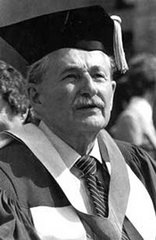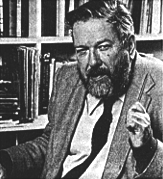I don't like to recycle material on this blog, but in response to several queries, he again is one person's view of what it means to be a Red Tory:
A red tory is a compassionate conservative, driven by a concern for community over individualism, the collective well-being over personal self-interest, Burke over Mill, social responsibility over token rights, societal responsibility over state responsibility, fiscal responsibility over socialism, and responsible government over mob rule. In particular, four (4) interrelated principles underlie "red toryism" as an ideology:
1. Tradition & Incrementalism: The tory philosophy is one in which society evolves gradually, remains stable but not static, and relies on tradition as a guide for the future.
2. Organicism & the Social Fabric: Core to the red tory ideology is the belief that society is more than a sum of its parts. It was Burke who invoked the term "social fabric" as a metaphor to describe society as a collection of individuals who, when woven together like threads, produce a much stronger and grander entity.
3. Ascription & Imperfection: The very essence of toryism is rooted in the Protestant belief in human imperfection, and the existence of a ‘natural hierarchy’ in society such that only the most capable should assume positions of authority. For red tories, while the social ladder exists, it is still accessible to those with lower social status, who may climb it gradually through their lifetimes and initiative, or over the course of several generations.
4. Paternalism & Noblesse Oblige: In essence, then, toryism is a belief system that combines paternalism and collectivism through the concept of ‘noblesse oblige’. In the tory view of community, one discovers a sense of mutual obligation – of duties and privileges, rights and responsibilities – such that those in positions of privilege owe concern to those of lower social and political status, while the latter owe a certain degree of deference to elites. Labeled "tory democracy", this set of values may help to explain the ebbing of red toryism in an age of declining social and political deference.Overall, red toryism implies an easy acceptance of, but a low tolerance for, economic and social inequality, and displays a communitarian concern for the care of the less-fortunate in society.
RED TORYISM & THE THIRD WAY
Ever notice the similarities between social democrats and red tories, these days? No, I'm not talking about Jack Layton -- I mean realistic social dems. If you cover up the byline, you may find yourself nodding at old Tony Blair, Ed Broadbent, Roy Romanow or Gary Doer speeches. It's no coincidence -- the so-called "Third Way" to which these men have committed themselves bears a striking resemblance to classic Red Toryism:
1. Fundamentally, both share an inclusive, organic view of society, including a belief in the necessity of mutual obligation to bind together members of the community. This view conflicts with the atomistic, liberal notion of society as a collection of competing individuals.
2. Both red toryism and the third way treat society and the market as separate, but interdependent. For red tories, this is embodied in the desire to put politics before economics when necessary; for social democrats, it means striving to prevent a market society from evolving out of a market economy.
3. In this vein, both ideologies also view the state as a positive instrument in society, and promote government intervention in the economy when necessary to promote the interests of the community (red toryism) or achieve social justice (the third way).
4. Yet, both are rooted in what Giddens (1998: 66) calls "philosophic conservatism," and stand opposed to revolutionary changes to society and its political institutions. Rooted in a strong distrust or dissatisfaction with the type of sweeping social plans embodied in socialism, red toryism and the third way advocate progressive, incremental reform.To say that Third Way social dems "stole" our doctrine is a little harsh. After all, imitation is the highest form of flattery. It does help to explain why some of us are drawn to moderates like Doer and Broadbent, though -- especially considering the socon and neocon leanings of so many so-called "Tory" leaders.
RED TORYISM AND THE REST OF THE CONSERVATIVE FAMILY
Perhaps the simplest way to conceptualize an ideology like conservatism is to divide it into a series of functional dimensions. In this case, six seem especially pertinent (dramatic oversimplifications of each term are given in parentheses):
(1) MORAL CONSERVATISM* (a.k.a., NEO-conservatism; emphasis on traditional family values; often, but not always, tied to religious beliefs)
(2) SOCIAL CONSERVATISM*^ (opposition to social engineering, including affirmative action; emphasis on law, order and security)
(3) FISCAL CONSERVATISM^ (a.k.a., neo-liberalism; emphasis on fiscal orthodoxy, including balanced budgets, deregulation, privatization, debt repayment, and tax relief; note: there is a distinction between being fiscally conservative and fiscally responsible -- politicians of all political stripes pay lip service to the latter)
(4) POPULISM~ (a belief in grass-roots democracy, often in opposition to political partisanship and other top-down institutions like Parliament; often, but not always, mixed with libertarianism; see: Thomas Jefferson)
(5) HIGH TORYISM~ (a belief in parliamentary sovereignty, often in opposition to direct democracy and judicial activism; often accompanied by a communitarian/patriotic view of the state; see: Alexander Hamilton and Edmund Burke)
(6) LIBERTARIANISM (a belief in the sovereignty of the individual and the limitations of government in the moral, social, and economic spheres)
*The distinction between #1 and #2 is no doubt the trickiest. In every-day language, both moral and social conservatives have been lumped under the "SO-CON" label. While there is a correlation between the two sets of values, it's important to distinguish between the two. Logically, a person could be a moral conservative without being a social conservative (and vice versa).
^Both social and fiscal conservatism often favour limited state interference in the economy, and a guaranteed but limited social welfare system.
~This is where there is often a direct conflict within conservative ranks, between those who favour a grass-roots style of politics and those that favour an elite-driven version.
People do not have to conform to any one of these labels. In fact, few, if any conservatives are members of only one 'camp'. As mentioned, people with moral and social conservative tendencies are often referred to as "SO-CONS". People with moderate fiscal conservative leanings and tendencies toward "high toryism" -- without a touch of moral or social conservatism -- are often called "RED TORIES". In the United States, the "NEW RIGHT" consists of "neo-cons" and "neo-liberals". And so on. The point is not to pigeon-hole people into one class of conservatism. Quite the opposite.
The purpose of this discussion has been to highlight how not all C/conservatives are created equal. The next time you hear someone painting us all with the same brush, think twice.





